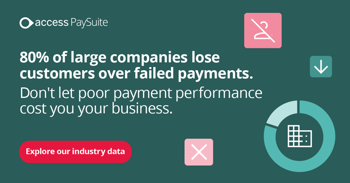
At AccessPaysuite, we've conducted extensive research into consumer opinions on payments, and the results are clear. People are changing how they pay for goods and services, and they expect organisations to keep pace. They expect the latest mobile wallet and Pay By Bank channels to be offered, along with direct card input or the option to set up a direct debit.
When companies fail to provide this, in a secure and transparent environment, the results are instant. Customers simply walk away. The UK Government estimates around 30% of online carts are abandoned at the checkout stage while the Baymard Institute believes the figures could go as high as 70% to 80%.

Regardless of this disparity, perhaps the more revealing finding is that the top three reasons for aborting a payment is hidden costs which suddenly appear (48%) at the checkout stage, such as shipping and tax, as well as have to set up an account (26%).
Drilling down deeper into payments, the third biggest concern is security. When organisations fail to show customers their check out is secure and their data will be handled safely, one in four customers will navigate away. Similarly, 13% are put off by not having the right payment options offered and 9% quit because of a declined card.
This is of course at the check-out stage and underlines the price organisations fail for not being transparent or secure as well as not offering the right choice and flexibility in payment options.
Payment failure is rife
Not many researchers delve into the requirements that follow the initial checkout process. However, for payments professionals, what happens next is equally important. When we surveyed customers in key payment industries about their experiences after making payments, the results were quite surprising.
In insurance of those customers who reported an issue -
- 39% have had payments continue to be made without them being aware
- 35% have had trouble cancelling payments
- 33% claim to have been overcharged
- 33% report problems with payments not going through properly
In financial services
- 40% of customers report a problem with payments in the past two years
- Failed payments (13%) trouble cancelling (10%) and being overcharged (9%) were the biggest problems recorded
In gyms
- 24% have had issues cancelling payments
- 24% have had trouble understanding membership and payment options
The cost of failure – customer churn
One only need glance an eye over the above figures to see the high prevalence of payment problems. These are not just caused by payments not going through but by potential procedural errors where they keep on being processed even after a customer has tried to cancel.
The cost is not just in having to employ staff to reconcile payments and intervene to attempt to correct mistakes and pacify customers. Even then, once people have spoken to support staff, one in three financial services customers, and nearly one in four gym goers, are unsatisfied with the level of support.
Just looking at the single issue of organisations not being able to process a payment at the first time of asking, researchers at Lexis Nexis estimate failed payments cost the global economy £95.3bn. Just as importantly, the researchers point out that the real price is to be found in damage to brand image and very high levels of churn.

Lexis Nexis research found
- 60% of companies reveal they lose customers because of failed payment issues
- 80% of large companies (20,000+ payments per day) lose customers over failed payments
It underlines the need to work with a payments partner who can not only set up the right channels and make sure they work well first time as often as possible. It also highlights the importance of flexible systems which are easy for staff to understand and fit around individual customers to ensure mistakes are reduced.
Ultimately, it shines a light on the importance of not just getting it right first time but also working with a payments partner who offers an organisation’s people the tools they need to resolve issues swiftly when they arise. The choice is stark because the price of payments failure is dissatisfied customers, a tarnished brand image and churn on a massive scale.